|
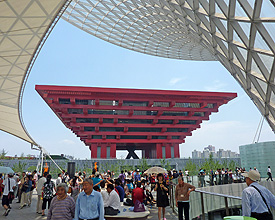 |
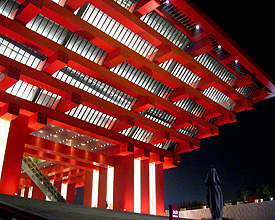 |
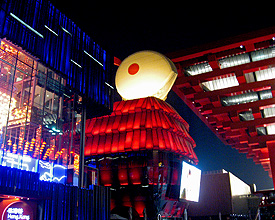 |
|
The Chinese Pavilion. It was impressive.
|
The Chinese Pavilion at night. It's unimaginably huge.
|
The Hong Kong and Macau pavilions are large, but they seem tiny next to the Chinese pavilion looming over them.
|
|
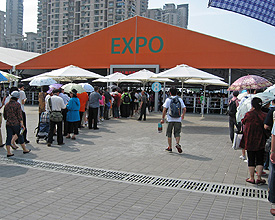 |
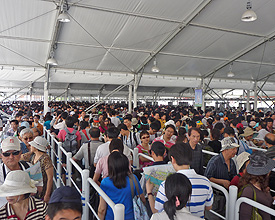 |
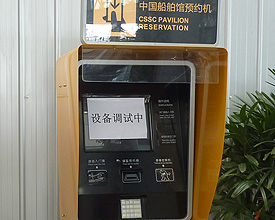 |
|
If you arrive before around 9:30 a.m. or 10:00 a.m. you'll need to wait in line for securty. Here is such a line in the morning about 15 minutes before the gates open. One morning we came at 7:00 a.m., but we still had about 1,000 people in front of us at our gate when the security started letting people in at 9:00 a.m.
|
When the gates open at 9:00 a.m., this line to go through security starts to move. The people near the back of this line might get into the park by 10:00 a.m. If you showed up at 10:30 you could just walk in without waiting.
|
Once you're in the park, it would be nice to have a large bank of computer terminals where one could make reservations for popular pavilions, and get time slot assignments, but usually this doesn't actually happen.
|
|
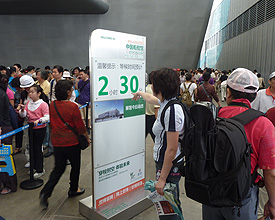 |
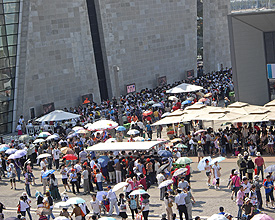 |
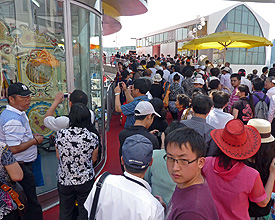 |
|
Since the World Expo doesn't have a working and functional system for people to make reservations for certain times at pavilions, most people must wait in line. Here is a typical line with a sign indicating a two-hour and 30-minute wait, and this is at about 9:45 a.m., not an hour after the gates have opened, and this is for a modestly popular pavilion (the ship-building pavilion).
|
Here is a view looking down from the Netherlands pavilion at people waiting in line for the Italian pavilion, which at the time, required about four hours of waiting to enter. Some line-ropes and signs were prepared for people to wait up to nine hours in particular lines. So, we decided we wouldn't be seeing any of the 40 or 50 most popular pavilions. We didn't want to wait in such long lines.
|
The Netherlands Pavilion had a very well-designed system for moving people through its displays and its pavilion, and thus, waits for this pavilion were under an hour. Here is a view of crowds making their way through the Netherlands Pavilion.
|
|
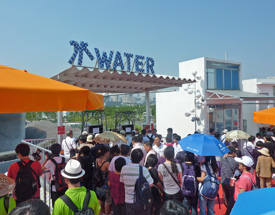 |
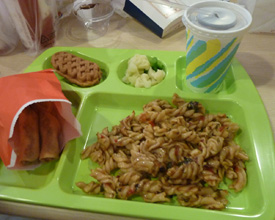 |
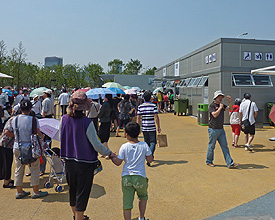 |
|
It was very hot at the World Expo, and water was generally expensive, although there were places (quite a few of them) where one could get free water. Here is a crowd around one such free water distribution place, in the Netherlands Pavilion.
|
Some restaurants had very long lines. I waited in one line for about 30 minutes, only to find when I reached the head of the line that the restaurant was out of food. Other restaurants were less crowded, and some in more out-of-the-way areas of the Expo were practially empty. The above lunch was purchased in the Latin Restaurant, and I guess it's a Chinese version of some sort of Mexican spicy noodle dish.
|
We did not see long lines for the washrooms and toilets. Generally the lines for these were short, and waiting was not ever more than a few minutes. Some toilet stalls had time indicators on front, so that people waiting in line could note how long each person took inside the toilet.
|
|
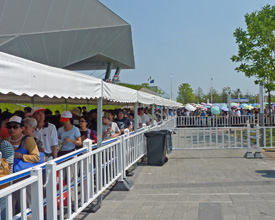 |
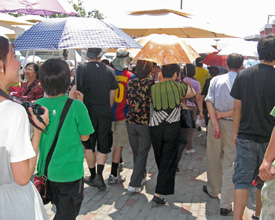 |
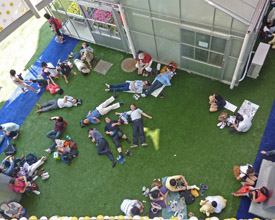 |
|
Lines such as this one could be avoided. We decided to visit less popular pavilions and do most of our pavilion-visiting in the last few hours (from 7:00 p.m. to 10:00 p.m.), when lines were shortest.
|
For much of World Expo, this is a view a child would have of the event. The crowds were thick.
|
The Netherlands Pavilion offered a soft place to lie down and get in a quick nap in the shade.
|
|
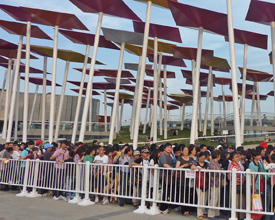 |
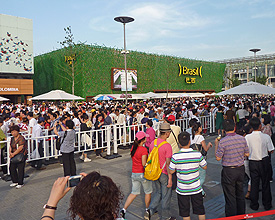 |
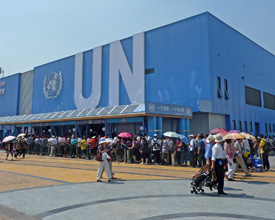 |
|
The Mexico Pavilion. Note the line, which was supposedly only about 90 minutes at around 7:00 p.m. when I took this photograph. That was still too long a wait for us. We went elsewhere after admiring the kites.
|
The Brazil Pavilion. I think the wait here was four or five hours, but I might be confusing it with the Argentina Pavilion. I don't know what was inside.
|
Ah, the UN Pavilion. This was a good one. We were able to get inside after only about a ten minute wait one late afternoon around 5:30. This pavilion was like a museum about international development. I loved it.
|
|
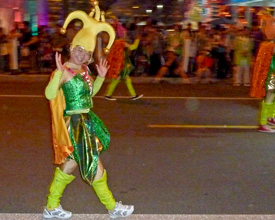 |
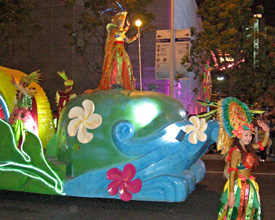 |
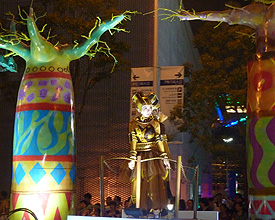 |
|
Expo evening parade.
|
Expo evening parade. Oceana?
|
Expo evening parade. Africa?
|
|
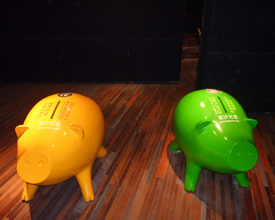 |
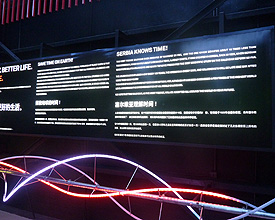 |
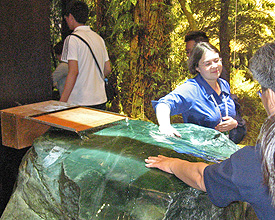 |
|
In the Estonian pavilion we could vote for what we thought was an important method for improving or "saving" cities. Voting was done by putting papers in these piggy banks. That was about it for this pavilion. It did help one think about what makes a city a good place to live, and the voting process was nice, as there was a chance that one's vote (on which one wrote one's address and name and phone number) would be drawn in a sort of lottery in which winners would receive trips to Estonia.
|
The Serbian Pavilion featured information about time, clocks, and calendars. The Serbians have a very accurate calender, and they urge the world to adopt it.
|
At about 9:30 p.m., just half an hour before the pavilions closed, there was no wait at all for the very cool New Zealand Pavilion. We decided this was the time to see modestly popular pavilions, and if I had a chance to do it all over, I'd just go in evenings and try to see moderately popular pavilions in the four hours after 6:00 p.m.
|
|
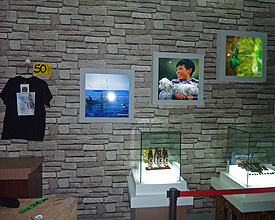 |
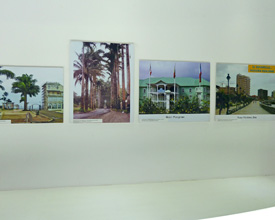 |
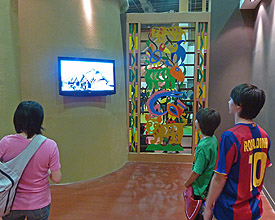 |
|
The joint pavilions weren't so crowded, so we spent time in these. Here are some photos in the Guatemala exhibit inside the Latin American and Central American Joint Pavilion. These joint pavilions weren't always so impressive, but they were indoors, out of the sun, and they were mildly interesting.
|
Some of the displays in the African joint pavilion were basically mere collections of photographs. Still, I haven't seen many photographs from places lie Equatoral Guinea, so I was still interested in what I could see.
|
The Benin exhibit in the joint African Pavilion seemed to have not been completed or filled. There were just a couple televisions showing videos, and that was all we could see in a rather large exhibition space with some interesting (but blank) walls.
|
|
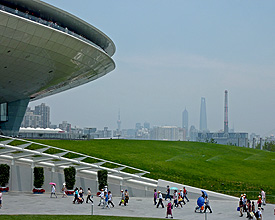 |
 |
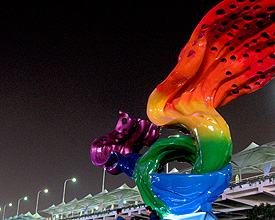 |
|
Shanghai has some far-out architecture, and the World Expo had some extreme examples of fun Chinese style. Here is the Culture Pavilion looming up like a massive landed alien spaceship looking out over the skyline of distant Pudong-Across-the-Bund.
|
My son Arthur took this photograph of a sign's warning that visitors shouldn't touch some displays in one of the exhibits in the African Joint Pavilion. The Chinese girl and her parents who were taking a photograph of her seemingly couldn't read or didn't care about such rules. If they had just waited for five hours for a glimpse of a pavilion after spending several weeks' salary and traveling many hours from some village in the remote interior of China I can hardly blame them for taking a lax attitude toward Expo rules.
|
In the evening when the sun had gone away and the crowds were not so thick I really enjoyed the atmosphere of the Expo architecture and landscaping. This statue, for example, seemed lovely to me.
|





























